Optimization Analysis of Partition Wall Support Scheme of Multi-Arch Tunnel
Abstract
1. Introduction
2. Project Description
2.1. Tunnel Overview
2.2. Geological Overview
2.3. Analysis of Engineering Issues
3. Numerical Simulation
3.1. Model and Parameters
3.2. Construction Scheme
3.3. Analysis of Simulation Results
3.3.1. Ground Settlement
3.3.2. Middle Partition Wall’s Deformation and Force
3.3.3. Initial Support Structure Deformation and Force
4. Analysis of Field Data
4.1. Ground Settlement
4.2. Tunnel Vault Settlement
5. Conclusions
- (1)
- The peak stratum deformation value under the mixed-support scheme was the largest, which occurred at the main hole’s vault in a variable cross-section position (CDK0+180) with a maximum value of 8.82 mm. After optimizing a single straight-wall support form, the ground settlement at the CDK0+180 section was decreased by 21.15%, which ensured stratum stability;
- (2)
- The middle partition wall was mostly under compressive stress. The mixed-support scheme had stress concentration at the sudden change section, which was the main reason for support structure cracking as well as bearing capacity and the middle partition wall’s integrity deterioration. After optimizing the single straight-wall support form, the partition wall effectively supported the surrounding rock and ensured stability and safety during construction;
- (3)
- Compared with the mixed-support scheme, peak displacement and compressive stress under a single straight wall were decreased by 54.74 and 21.47%, respectively, which ensured support structure stability and effectively constrained surrounding rock cracking;
- (4)
- The triple-arch tunnel numerical model established in this study reflected the force and deformation in actual construction to a certain extent. Meanwhile, the numerical simulation results have been well applied to the actual project, improving construction efficiency and decreasing construction costs. It is suggested that such methods could be applied to invert the calculation parameters and construction schemes before other similar projects are constructed, which has a certain guiding significance for safe construction.
Author Contributions
Funding
Data Availability Statement
Conflicts of Interest
References
- Song, Z.P.; Shi, G.L.; Zhao, B.Y.; Zhao, K.M.; Wang, J.B. Study of the stability of tunnel construction based on double-heading advance: Construction method. Adv. Mech. Eng. 2019, 12, 1–17. [Google Scholar] [CrossRef]
- Song, Z.P.; Mao, J.C.; Tian, X.X.; Zhang, Y.W.; Wang, J.B. Optimization analysis of controlled blasting for passing through houses at close range in super-large section tunnels. Shock Vib. 2019, 2019, 1941436. [Google Scholar] [CrossRef]
- Alsirawan, R.; Sheble, A.; Alnmr, A. Two-dimensional numerical analysis for TBM tunneling-induced structure settlement: A proposed modeling method and parametric study. Infrastructures 2023, 8, 88. [Google Scholar] [CrossRef]
- Song, Z.P.; Cheng, Y.; Tian, X.X.; Wang, J.B.; Yang, T.T. Mechanical properties of limestone from Maixi tunnel under hydro-mechanical coupling. Arab. J. Geosci. 2020, 13, 402. [Google Scholar] [CrossRef]
- Guo, A.P.; He, M.C.; Liu, S.Y.; Du, Z.F.; Lyu, Z.; Tao, Z.G. Negative Poisson’s ratio cable compensation support for 32 m super-large-span highway tunnel: A case study. Undergr. Space 2023, 14, 156–175. [Google Scholar] [CrossRef]
- Li, L.P.; Fan, H.Y.; Liu, H.L. Model test and numerical simulation research on the mechanical response law of lager span and small interval tunnels constructed by CD method. Tunn. Undergr. Space Technol. 2022, 132, 104947. [Google Scholar] [CrossRef]
- Tian, Y.; Qaytmas, A.M.; Lu, D.C.; Du, X.L. Stress path of the surrounding soil during tunnel excavation: An experimental study. Transp Geotech. 2023, 38, 100917. [Google Scholar] [CrossRef]
- Luo, M.R.; Zhang, C.Y.; Wang, B.; Zeng, Y.H. Discrete element-based regression analysis of initial ground stress and application to an extra-long tunnel in China. Bull. Eng. Geol. Environ. 2023, 82, 405. [Google Scholar] [CrossRef]
- Wang, J.B.; Zhou, P.Y.; Song, Z.P.; Li, S.H.; Zhang, Q. A new calculation method for tunneling-caused stratum settlement. KSCE J. Civ. Eng. 2022, 26, 2624–2640. [Google Scholar] [CrossRef]
- Thirukumaran, S.; Oliveira, D. Innovative design of slender rock pillar formed within large span road tunnels and cavern Y-junction in Hawkesbury Sandstone. Tunn. Undergr. Space Technol. 2023, 141, 105376. [Google Scholar] [CrossRef]
- Sun, Z.Y.; Zhang, D.L.; Fang, Q.; Wang, J.C.; Chu, Z.F.; Hou, Y.J. Analysis of interaction between tunnel support system and surrounding rock for underwater mined tunnels considering the combined effect of blasting damage and seepage pressure. Tunn. Undergr. Space Technol. 2023, 141, 105314. [Google Scholar] [CrossRef]
- Sui, Y.; Cheng, X.H.; Zhao, Z.Z.; Ma, W.B. Investigation of cracking mechanism of the first tunnel lining during double-arch tunnel construction. Tunn. Undergr. Space Technol. 2024, 14, 1–17. [Google Scholar] [CrossRef]
- Fan, S.Y.; Song, Z.P.; Li, X.; Zhang, Y.W.; Liu, L.B.C. Investigation into the large deformation mechanism and control technology of variable cross-section yunnel in layered mudstone stratum. Buildings 2023, 13, 110. [Google Scholar] [CrossRef]
- Song, Z.P.; Shi, G.L.; Wang, J.B. Research on management and application of tunnel engineering based on BIM technology. J. Civ. Eng. Manag. 2019, 25, 785–797. [Google Scholar] [CrossRef]
- Han, Y.F.; Liu, X.R.; Zhou, X.H.; Deng, Z.Y.; Wang, Z.H.; Lai, G.S.; Zhang, G. Experimental study on the progressive failure behaviour of shallow tunnel-type anchorage in soft-rock strata using digital image correlation. Measurement 2023, 206, 112220. [Google Scholar] [CrossRef]
- Huo, R.K.; Zhou, P.ey.; Song, Z.P.; Wang, J.B.; Li, S.H.; Zhang, Y.W. Study on the settlement of large-span metro station’s baseplate caused by the tunnels newly built beneath it. Adv. Mech. Eng. 2019, 11, 1–13. [Google Scholar] [CrossRef]
- Wang, C.W.; Liu, X.L.; Song, D.Q.; Wang, E.Z.; Zhang, J.M. Elasto-plastic analysis of the surrounding rock mass in circular tunnel using a new numerical model based on generalized nonlinear unified strength theory. Comput. Geotech. 2023, 154, 105163. [Google Scholar] [CrossRef]
- Lin, H.; Yang, R.S.; Li, Y.L.; Fang, S.Z. Deformation mechanism and control technology of coal roadway with thin sand-mudstone interbed roof. Min. Metall. Explor. 2023, 41, 421–433. [Google Scholar] [CrossRef]
- Zucca, M.; Valente, M. On the limitations of decoupled approach for the seismic behaviour evaluation of shallow multi-propped underground structures embedded in granular soils. Eng. Struct. 2020, 211, 110497. [Google Scholar] [CrossRef]
- Jin, B.; Liu, Y.; Yang, C.X.; Tan, Z.C.; Zhang, J.Y. Construction technique of long-span shallow-buried tunnel considering the optimal ssequence of pilot-tunnel excavation. Adv. Mater. Sci. Eng. 2015, 2015, 491689. [Google Scholar] [CrossRef]
- Song, Z.P.; Tian, X.X.; Liu, Q.; Zhang, Y.W.; Li, H.; Zhou, G.N. Numerical analysis and application of the construction method for the small interval tunnel in the turn line of metro. Sci. Prog. 2020, 103, 0036850420932067. [Google Scholar] [CrossRef] [PubMed]
- Chen, Z.Q.; He, C.; Xu, G.W.; Ma, G.Y.; Wu, D. A case study on the asymmetric deformation characteristics and mechanical behavior of deep-buried tunnel in phyllite. Rock Mech. Rock. Eng. 2019, 52, 4527–4545. [Google Scholar] [CrossRef]
- Yang, S.Q.; Tao, Y.; Xu, P.; Chen, M. Large-scale model experiment and numerical simulation on convergence deformation of tunnel excavating in composite strata. Tunn. Undergr. Space Technol. 2019, 94, 103133. [Google Scholar] [CrossRef]
- Liu, D.P.; Zhang, D.L.; Fang, Q.; Sun, Z.Y.; Luo, J.W.; Li, A. Field monitoring of the deformation and internal forces of the surrounding rock and support structures in the construction of a super-span high-speed railway tunnel-A case study. Appl. Sci. 2020, 10, 5182. [Google Scholar] [CrossRef]
- He, M.C.; Guo, A.P.; Du, Z.F.; Liu, S.Y.; Zhu, C.; Cao, S.D.; Tao, Z.G. Model test of negative poisson’s ratio cable for supporting super-large-span tunnel using excavation compensation method. J. Rock Mech. Geotech. 2023, 25, 1355–1369. [Google Scholar] [CrossRef]
- Tian, X.X.; Song, Z.P.; Wang, J.B. Study on the propagation law of tunnel blasting vibration in stratum and blasting vibration reduction technology. Soil Dyn. Earthq. Eng. 2019, 126, 105813. [Google Scholar] [CrossRef]
- Fan, S.Y.; Song, Z.P.; Xu, T.; Wang, K.M.; Zhang, Y.W. Tunnel deformation and stress response under the bilateral foundation pit construction—A case study. Arch. Civ. Mech. Eng. 2021, 21, 109. [Google Scholar] [CrossRef]
- Xu, X.J.; Song, Z.P.; Li, H.; Tian, X.X.; Zhou, G.N. Unification of the mechanical model and parameter analysis of the elastic foundation beam of pipe-roof. Front. Earth Sci. 2022, 10, 803670. [Google Scholar] [CrossRef]
- Shi, J.W.; Zhou, P.Y.; Li, X.; Fan, S.Y.; Zhou, Z.F.; Zhi, B.; Cheng, Y. Study of the disaster-causing mechanism and reinforcement measures for soft rock deformation and lining cracking. Front. Earth Sci. 2023, 10, 1096635. [Google Scholar] [CrossRef]
- Zhang, W.; Liang, G.L.; Liang, Y.; Zhang, Z.J.; Xiao, C.Y. Dynamic responses of a coupled tunnel with large span and small clear distance under blasting load of the construction of transverse passage. Appl. Sci. 2023, 13, 8599. [Google Scholar] [CrossRef]
- Wang, Q.; Luan, Y.C.; Jiang, B.; Li, S.C.; Yu, H.C. Mechanical behaviour analysis and support system field experiment of confined concrete arches. J. Cent. South Univ. 2019, 26, 970–983. [Google Scholar] [CrossRef]
- Xie, S.R.; Pan, H.; Zeng, J.C.; Wang, E.; Chen, D.D.; Zhang, T.; Peng, X.J.; Yang, J.H.; Chen, F.; Qiao, S.X. A case study on control technology of surrounding rock of a large section chamber under a 1200-m deep goaf in Xingdong coal mine, China. Eng. Fail. Anal. 2019, 104, 112–125. [Google Scholar] [CrossRef]
- Chen, Z.Q.; He, C.; Xu, G.W.; Ma, G.Y.; Yang, W.B. Supporting mechanism and mechanical behavior of a double primary support method for tunnels in broken phyllite under high geo-stress: A case study. Bull. Eng. Geol. Environ. 2019, 78, 5253–5267. [Google Scholar] [CrossRef]
- Li, B.; Ding, Q.F.; Xu, N.W.; Lei, Y.F.; Xu, Y.; Zhu, Z.P.; Liu, J.F. Mechanical response and stability analysis of rock mass in high geostress underground powerhouse caverns subjected to excavation. J. Cent. South Univ. 2021, 28, 982. [Google Scholar] [CrossRef]
- Bian, W.H.; Yang, J.; Wang, K.X.; Xu, D.M. Application of excavation compensation method for constructing shallowly-buried super-large span subway tunnel. Case Stud. Constr. Mater. 2023, 19, 02388. [Google Scholar] [CrossRef]
- He, J.X.; He, S.H.; Liu, X.B.; Ma, J.F.; Li, Y.M.; Zhang, B. Investigating the mechanical responses and construction optimization for shallow super-large span tunnels in weathered tuff stratum based on field monitoring and Flac3D modeling. Int. J. Civ. Eng. 2023. [Google Scholar] [CrossRef]
- Alsirawan, R.; Koch, E.; Alnmr, A. Proposed Method for the Design of Geosynthetic-Reinforced Pile-Supported (GRPS) Embankments. Sustainability 2023, 15, 6196. [Google Scholar] [CrossRef]
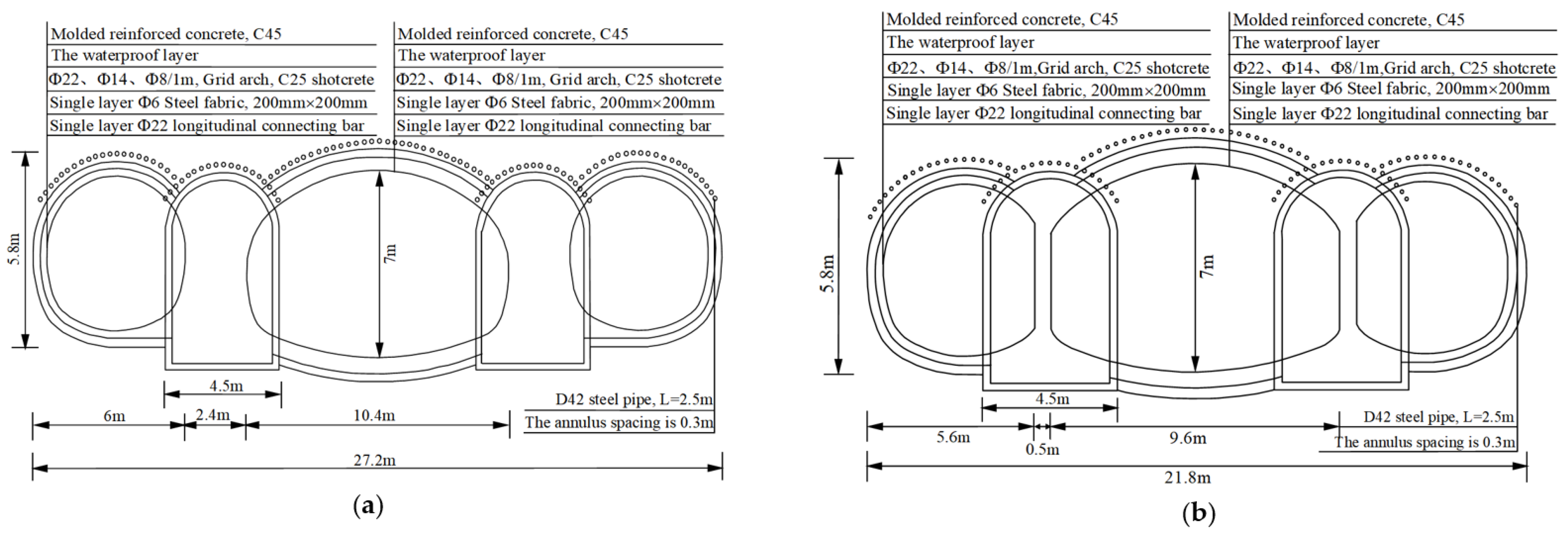

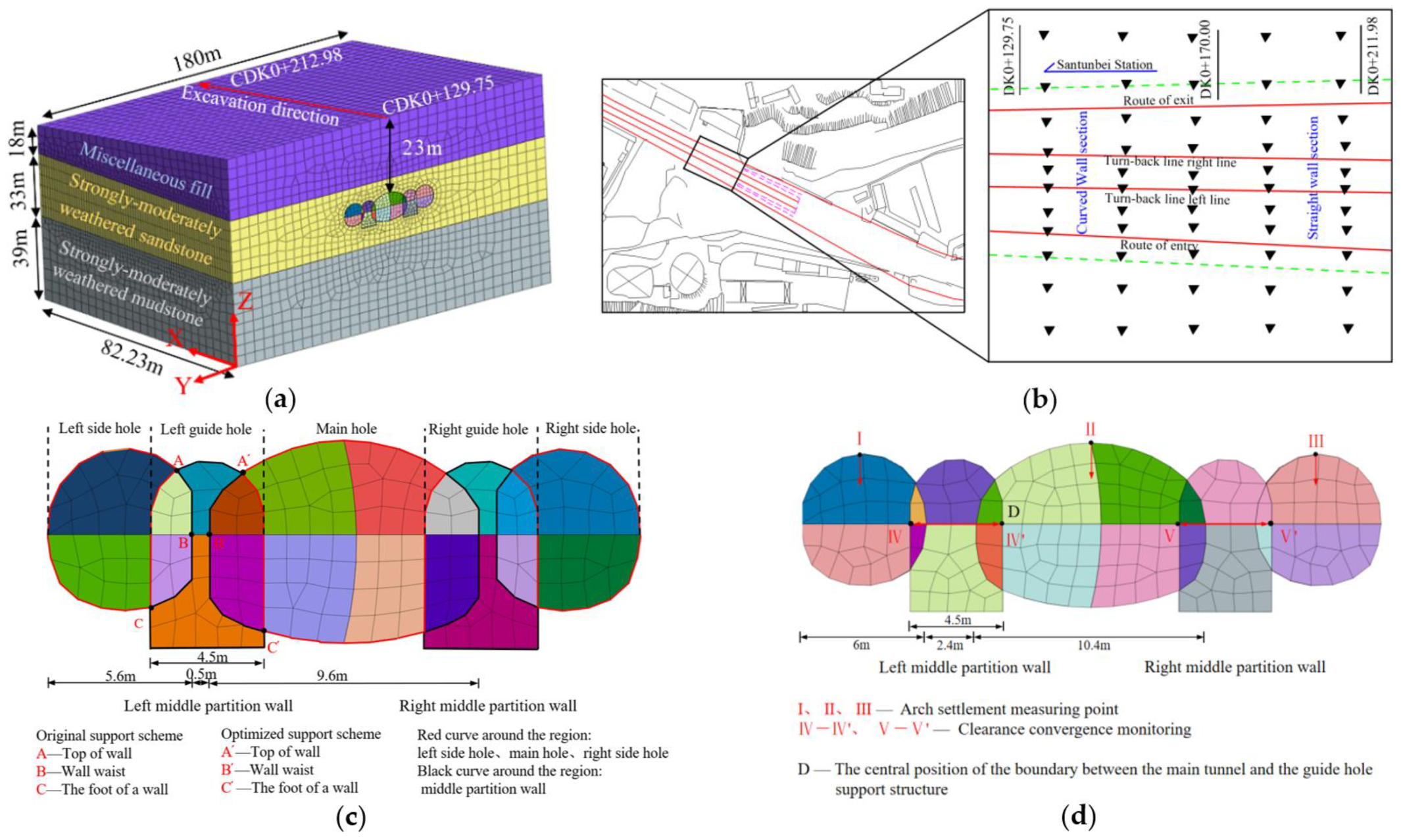


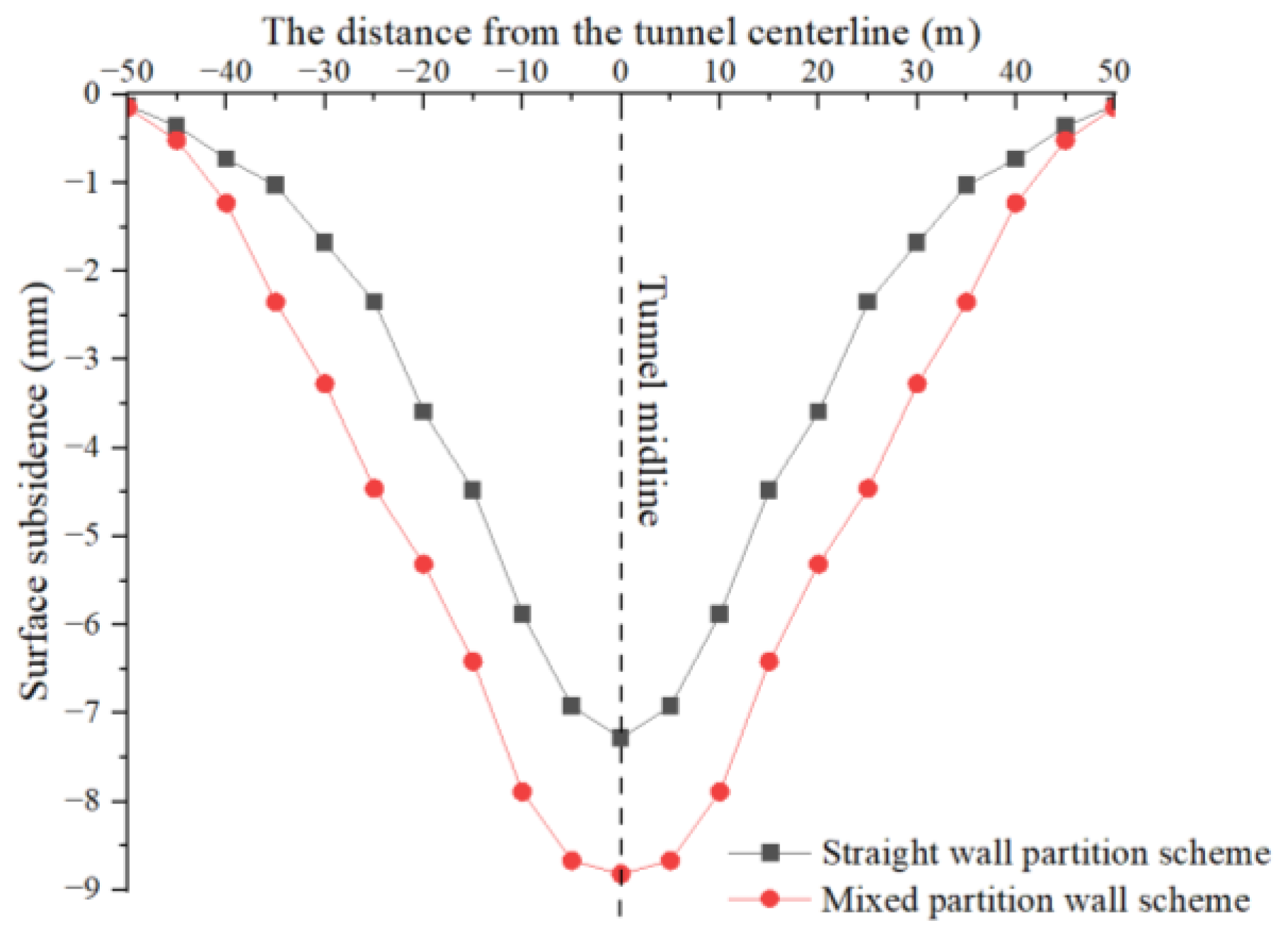


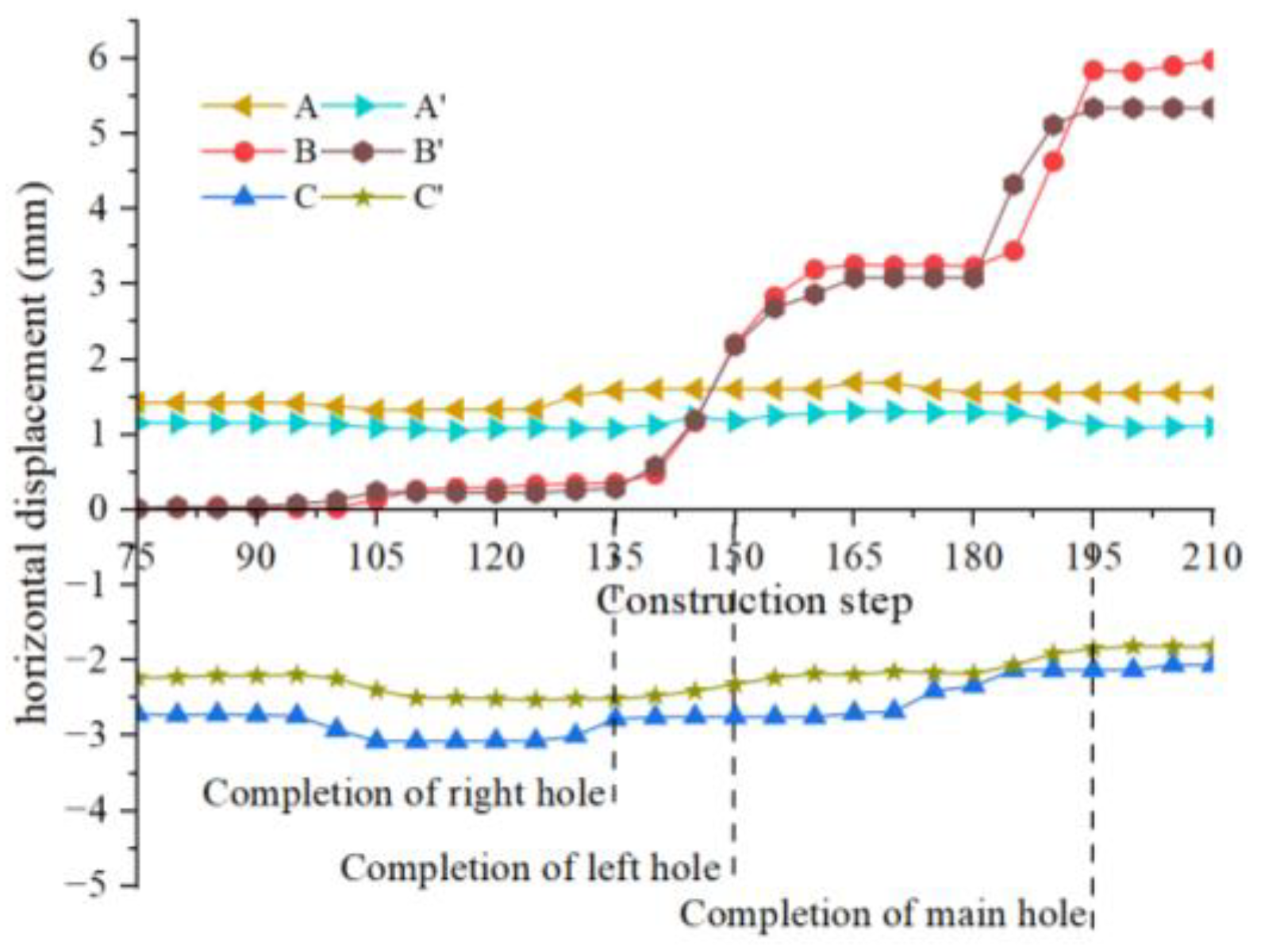








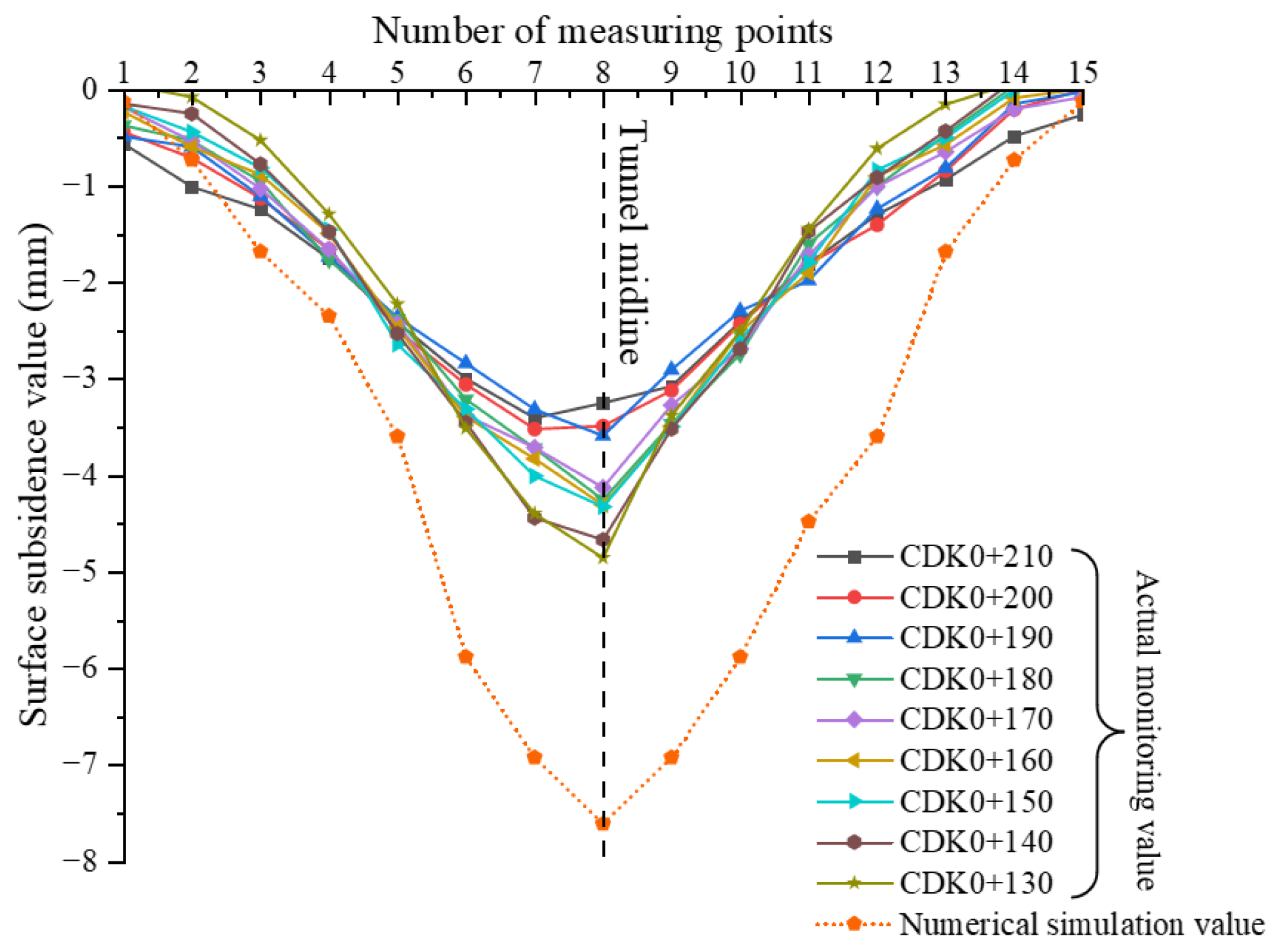
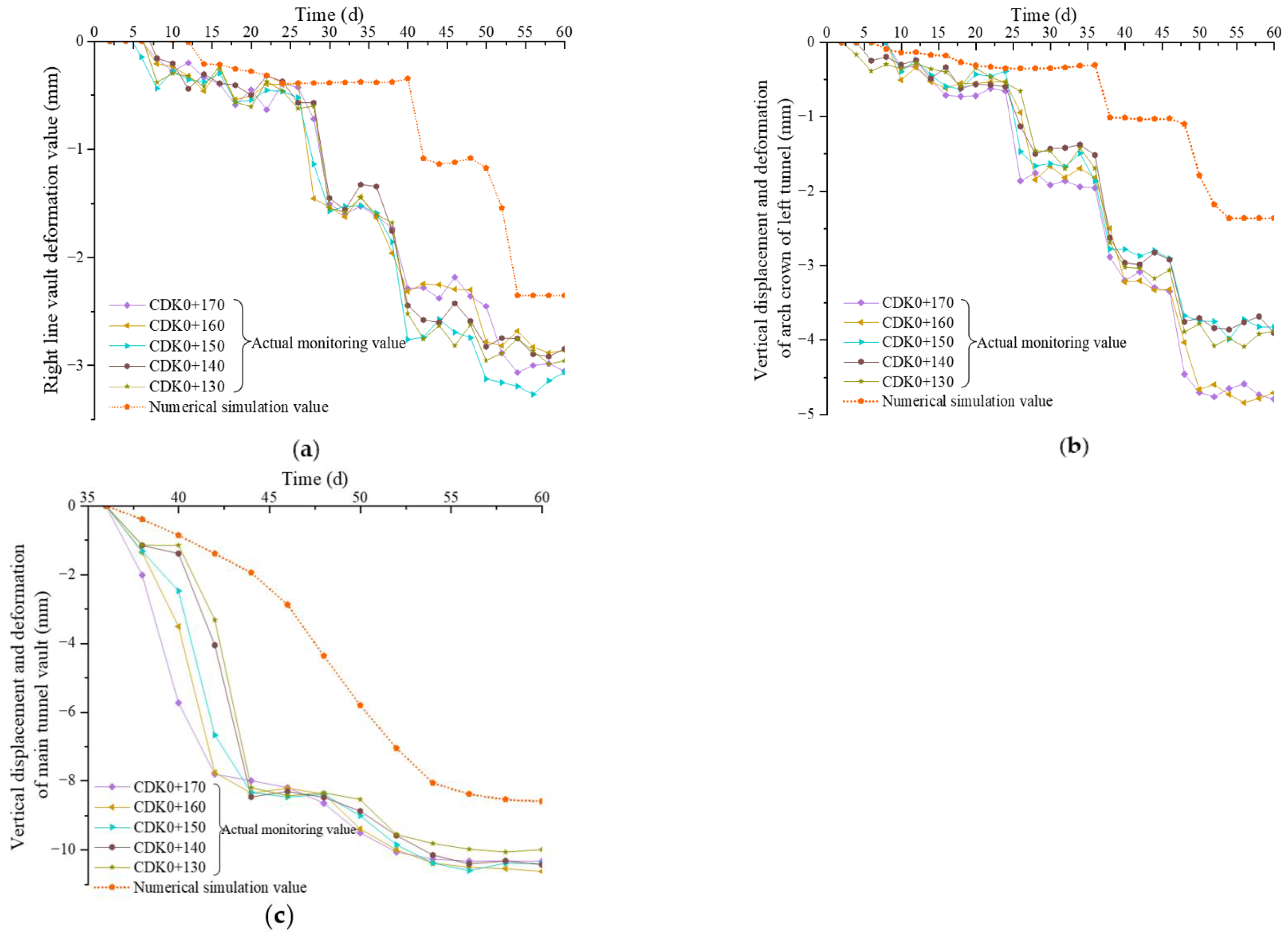
| Layer Name | ρ (g/cm3) | E (MPa) | μ | c (kPa) | φ (°) |
|---|---|---|---|---|---|
| Miscellaneous fill | 1.9 | 20.0 | 0.30 | 8.0 | 10.0 |
| Silty clay | 2.0 | 9.0 | 0.26 | 32.0 | 15.0 |
| Mudstone | 2.37 | 2.0~2.5 × 103 | 0.19~0.17 | 30.0~50.0 | 25.0~30.0 |
| Sandstone | 2.49 | 2.4~2.9 × 103 | 0.13~0.16 | 87.0~130.0 | 30.0~35.0 |
| Conglomerate | 2.57 | 4.7~5.0 × 103 | 0.11~0.13 | 155.0~210.0 | 40.0~45.0 |
| Name | Element Type | Constitutive Model | E (kPa) | γ (kN/m3) | μ | c (kPa) | φ (°) |
|---|---|---|---|---|---|---|---|
| Miscellaneous fill | Entity units | Mohr–Coulomb | 2.0 × 104 | 19.0 | 0.26 | 2 | 10 |
| Strongly–moderately weathered sandstone | Entity units | Mohr–Coulomb | 2.4 × 106 | 24.9 | 0.16 | 87 | 30 |
| Strongly–moderately weathered mudstone | Entity units | Mohr–Coulomb | 2.5 × 106 | 23.7 | 0.17 | 50 | 30 |
| Initial support of main hole | Plate element | Elasticity | 29.7 × 106 | 37.5 | 0.20 | - | - |
| Initial support of side hole | Plate element | Elasticity | 30.1 × 106 | 35.2 | 0.20 | - | - |
| Middle wall | Entity units | Elasticity | 20 × 106 | 25.0 | 0.20 | - | - |
Disclaimer/Publisher’s Note: The statements, opinions and data contained in all publications are solely those of the individual author(s) and contributor(s) and not of MDPI and/or the editor(s). MDPI and/or the editor(s) disclaim responsibility for any injury to people or property resulting from any ideas, methods, instructions or products referred to in the content. |
© 2024 by the authors. Licensee MDPI, Basel, Switzerland. This article is an open access article distributed under the terms and conditions of the Creative Commons Attribution (CC BY) license (https://creativecommons.org/licenses/by/4.0/).
Share and Cite
Yang, S.-Q.; Li, X.-L.; Zhang, W.; Fan, S.-Y.; Liu, L.-B. Optimization Analysis of Partition Wall Support Scheme of Multi-Arch Tunnel. Buildings 2024, 14, 490. https://doi.org/10.3390/buildings14020490
Yang S-Q, Li X-L, Zhang W, Fan S-Y, Liu L-B. Optimization Analysis of Partition Wall Support Scheme of Multi-Arch Tunnel. Buildings. 2024; 14(2):490. https://doi.org/10.3390/buildings14020490
Chicago/Turabian StyleYang, Shun-Qing, Xue-Li Li, Wei Zhang, Sheng-Yuan Fan, and Lian-Baichao Liu. 2024. "Optimization Analysis of Partition Wall Support Scheme of Multi-Arch Tunnel" Buildings 14, no. 2: 490. https://doi.org/10.3390/buildings14020490
APA StyleYang, S.-Q., Li, X.-L., Zhang, W., Fan, S.-Y., & Liu, L.-B. (2024). Optimization Analysis of Partition Wall Support Scheme of Multi-Arch Tunnel. Buildings, 14(2), 490. https://doi.org/10.3390/buildings14020490






